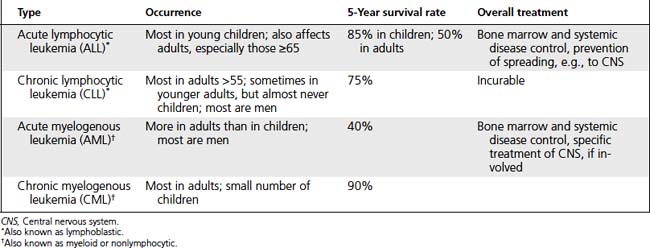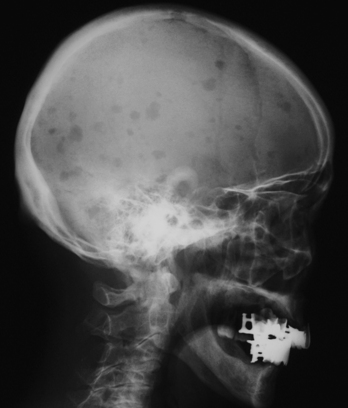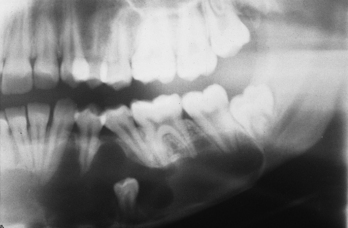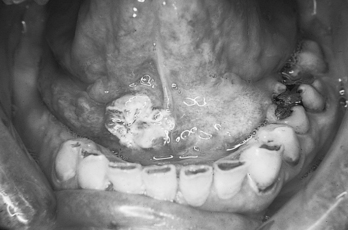CHAPTER 6 General and Oral Pathology
PATHOLOGY
General pathology includes the study of the destruction and repair of bodily tissues. Oral pathology is the study of the destructive conditions associated with the mouth, head, neck. Can be either primary or secondary (follows and results from an earlier disease), or there can be comorbidity, with more than one pathological condition present. MOST conditions and diseases go through periods of exacerbation (relapse, attack, flare-up), with an increase in the severity of a disease or its symptoms, as well as periods of remission (absence of disease activity).
INJURY, INFLAMMATION, AND REPAIR
Diagnostic Process
Infectious Diseases
Metabolic Disorders
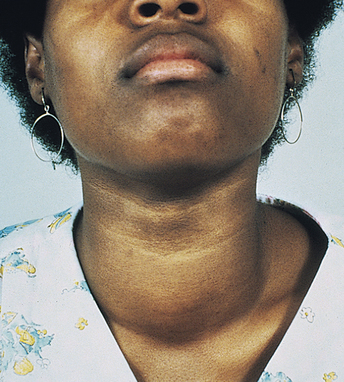
Figure 6-1 Goiter formation from thyroid gland disorder.
(From Fehrenbach MJ, Herring SW: Illustrated anatomy of the head and neck, ed 3, St. Louis, 2008, Saunders/Elsevier.)
Box 6-1 Monitoring Levels of Blood Glucose
CLINICAL STUDY
| Age | 37 YRS | SCENARIO |
| Sex |  Male Male  Female Female |
A patient new to the dental practice is at the end of the 2-hour afternoon appointment. She starts complaining of a headache, reports feeling weak, and becomes more nervous and somewhat confused. |
| Height | 5′;0″ | |
| Weight | 210 LBS | |
| BP | 112/68 | |
| Chief Complaint | “I was so nervous about this dental appointment that I forgot to eat lunch today.” | |
| Medical History | Diabetes mellitus (well controlled) for 2 years Osteopenia for 1 year | |
| Current Medications | 250 mg chlorpropamide (Diabinese) qd OTC calcium supplement with vitamin D qd | |
| Social History | Interior decorator |
Blood Disorders
CLINICAL STUDY
| Age | 12 YRS | SCENARIO |
| Sex |  Male Male  Female Female |
During her initial intraoral examination, gingival bleeding, poor oral hygiene, three carious lesions, and two nearly exfoliated teeth are observed. Physician wants oral cavity checked for signs of infection. |
| Chief Complaint | “My grandmother is so scared since my gums are bleeding so much!” | |
| Medical History | Recent diagnosis of leukemia with intensive chemotherapy scheduled in 1 week | |
| Current Medications | None at this time | |
| Social History | Grade school student studying ballet Grandmother is guardian |
Bone Diseases
Neoplasia
CLINICAL STUDY
| Age | 50 YRS | SCENARIO |
| Sex |  Male Male  Female Female |
The lesion noted on intraoral examination of the patient appears to be a preexisting mole that is 5 mm in diameter and has a raised, irregular, and reddened border on its anterior surface. |
| Height | 5′10″ | |
| Weight | 140 LBS | |
| BP | 105/70 | |
| Chief Complaint | “My mole becomes sore and bleeds and I think it is getting larger!” | |
| Medical History | Past history of repeated urinary tract infections Gallbladder removed 5 years ago | |
| Current Medications | OTC ginseng qd | |
| Social History | High school teacher who spends many hours sunbathing every summer and uses tanning booths in the winter to maintain her tan, since she has very pale skin |
CLINICAL STUDY
| Age | 65 YRS | SCENARIO |
| Sex |  Male Male  Female Female |
The patient indicates that he noticed the sore several months ago. Intraoral examination reveals a 10-mm ulcerated red lesion located on the left lateral border of the tongue. |
| Height | 6′2″ | |
| Weight | 195 LBS | |
| BP | 112/72 | |
| Chief Complaint | “This sore in my mouth really hurts!” | |
| Medical History | Smokes a pack of cigarettes a day Started smoking when he was 15 Consumes alcoholic beverages on the weekends | |
| Current Medications | None | |
| Social History | Farmer Volunteer firefighter |
Cancer Patient Care
Stay updated, free dental videos. Join our Telegram channel

VIDEdental - Online dental courses


 •
• 